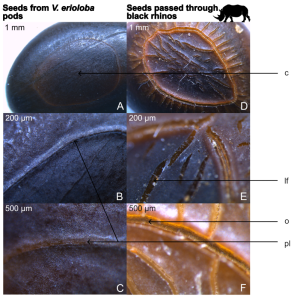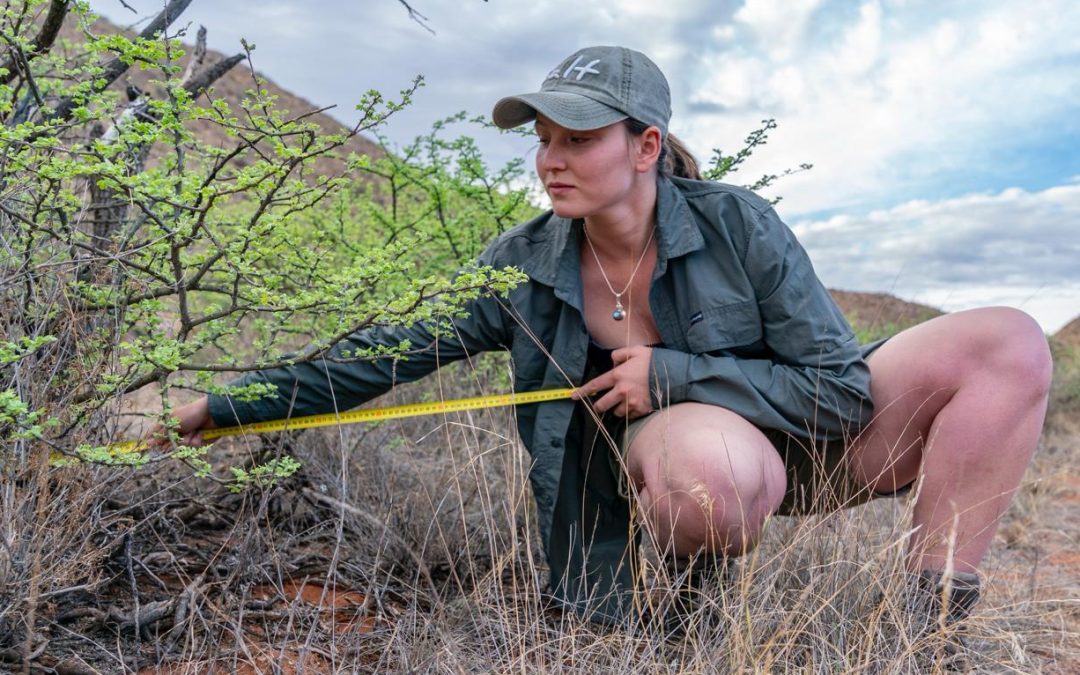Megaherbivores (animals over 1,000 kg), such as the African black rhinoceros Diceros bicornis, have been historically viewed as agents of top-down control, limiting woody plant growth through destructive foraging or debarking. However, recent experimental research focusing on the black rhino in the southern Kalahari Desert, South Africa, reveals a surprising and crucial facilitative role: a significant mutualistic relationship with the camel thorn tree, Vachellia erioloba.
This study, conducted at the Tswalu Kalahari Private Game Reserve by Masters graduate Olivia Jones, shows that black rhinos act as effective endozoochorous seed dispersers.
“Endozoochory is a mechanism whereby an animal disperses a seed by ingesting it,” says Jones, “a good example is birds eating berries; the seeds are translocated while carried inside the digestive tract and simultaneously primed to germinate through exposure to gut acids and enzymes.”
The germination secret in the dung
Vachellia erioloba is a key tree species in arid savannas, known for improving soil fertility and supporting biodiversity. Its seeds are protected by hard, semi-water-impermeable coats that delay germination, a trade-off enhancing longevity but inhibiting rapid sprouting. Jones found that rhino gut passage overcomes this hurdle.
“The seeds that had been through the gut of the rhinos were cracked and swollen, which indicates that they were a lot more permeable to water which would accelerate germination,” said Jones, “they need facilitation by herbivores to help them get out of their seed coat and break that physical dormancy.”
The seeds recovered from rhino dung germinated very differently from pod seeds. There was a large initial flush of germinations, which did not happen in the other group. Dung-derived individuals also continued to germinate for 13 more days. In total, 40 % more seeds from dung germinated successfully than that of the untreated seeds.

Microscopic inspection revealed that dung-derived seeds were swollen, lighter in colour, and displayed cracked, softened seed coats with tears, indicating increased permeability to water.
Why is this prolonged germination so important?
In semi-arid environments like the Kalahari, rainfall is unpredictable.
The results of the study mean that, when black rhinos consume camelthorn pods, gut passage effects make seeds germinate earlier, and for an extended period. This produces a larger seedling population with both older individuals and greater age variation.
This variation offers a bet-hedging survival strategy: “The seedling demographic that results from gut passage effects and the extended time over which seeds would emerge increases the probability that, in the field, some seedlings by chance germinate during suitable conditions (e.g., enough rain) and reach a fit growth stage before experiencing disturbances (e.g., herbivory or fire) – so more might survive,” says Jones. “Also, rhinos dispersing seeds away from the parent plant reduces their time spent on the ground and may help seeds escape another form of disturbance, predation by insects.”
Potential implications
Ultimately, it is possible that more young camelthorns survive to maturity.
Given that black rhinos are the largest browsing herbivores capable of persisting in fenced, arid reserves across southern Africa, their contribution to camelthorn seed dispersal and germination may significantly influence vegetation structure and community composition over time. This could have many knock-on effects for ecosystem health and function.
If rhinos weren’t limited to reserves and they could traverse their natural migration routes, they may even help camelthorns shift in distribution with dispersal, helping them to track habitable environments as climatic changes affect conditions.
While we can speculate, we still need to study the impact of the discovered mechanism, gut passage effects on germination, at the landscape scale.
A nuanced view of megaherbivores
The findings support a more nuanced understanding of megaherbivores as both disturbance agents and mutualists.
While further long-term field research is needed to quantify the full ecological consequences in natural settings, this study addresses a longstanding bias in megaherbivore studies towards the African savanna elephant and provides the first experimental evidence of a black rhino-plant mutualism with camelthorns.
Feature photo: MSc student, Olivia Jones, performing field experiments in the Tswalu Kalahari Private Game Reserve. (Photo credit: Trevor Kleyn)


